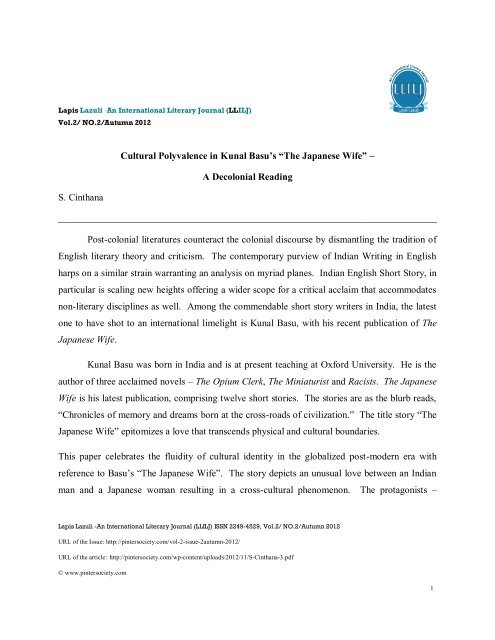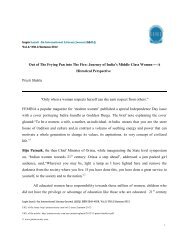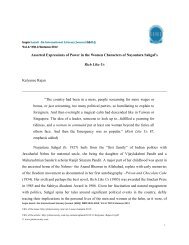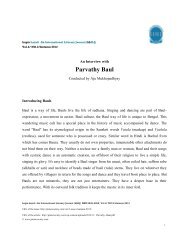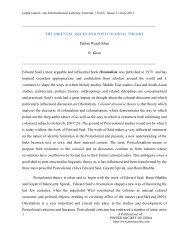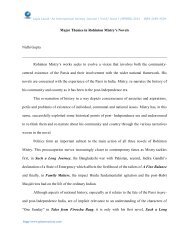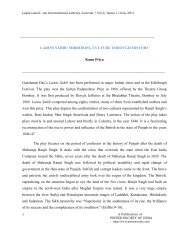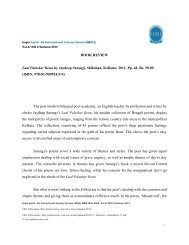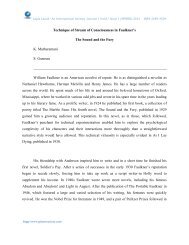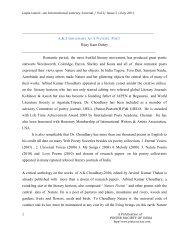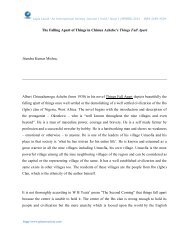Cultural Polyvalence in Kunal Basu's “The Japanese ... - lapis lazuli
Cultural Polyvalence in Kunal Basu's “The Japanese ... - lapis lazuli
Cultural Polyvalence in Kunal Basu's “The Japanese ... - lapis lazuli
Create successful ePaper yourself
Turn your PDF publications into a flip-book with our unique Google optimized e-Paper software.
Lapis Lazuli -An International Literary Journal (LLILJ)<br />
Vol.2/ NO.2/Autumn 2012<br />
S. C<strong>in</strong>thana<br />
Lapis Lazuli -An International Literary Journal (LLILJ) ISSN 2249-4529, Vol.2/ NO.2/Autumn 2012<br />
URL of the Issue: http://p<strong>in</strong>tersociety.com/vol-2-issue-2autumn-2012/<br />
URL of the article: http://p<strong>in</strong>tersociety.com/wp-content/uploads/2012/11/S-C<strong>in</strong>thana-3.pdf<br />
© www.p<strong>in</strong>tersociety.com<br />
<strong>Cultural</strong> <strong>Polyvalence</strong> <strong>in</strong> <strong>Kunal</strong> Basu’s <strong>“The</strong> <strong>Japanese</strong> Wife” –<br />
A Decolonial Read<strong>in</strong>g<br />
______________________________________________________________________________<br />
Post-colonial literatures counteract the colonial discourse by dismantl<strong>in</strong>g the tradition of<br />
English literary theory and criticism. The contemporary purview of Indian Writ<strong>in</strong>g <strong>in</strong> English<br />
harps on a similar stra<strong>in</strong> warrant<strong>in</strong>g an analysis on myriad planes. Indian English Short Story, <strong>in</strong><br />
particular is scal<strong>in</strong>g new heights offer<strong>in</strong>g a wider scope for a critical acclaim that accommodates<br />
non-literary discipl<strong>in</strong>es as well. Among the commendable short story writers <strong>in</strong> India, the latest<br />
one to have shot to an <strong>in</strong>ternational limelight is <strong>Kunal</strong> Basu, with his recent publication of The<br />
<strong>Japanese</strong> Wife.<br />
<strong>Kunal</strong> Basu was born <strong>in</strong> India and is at present teach<strong>in</strong>g at Oxford University. He is the<br />
author of three acclaimed novels – The Opium Clerk, The M<strong>in</strong>iaturist and Racists. The <strong>Japanese</strong><br />
Wife is his latest publication, compris<strong>in</strong>g twelve short stories. The stories are as the blurb reads,<br />
“Chronicles of memory and dreams born at the cross-roads of civilization.” The title story <strong>“The</strong><br />
<strong>Japanese</strong> Wife” epitomizes a love that transcends physical and cultural boundaries.<br />
This paper celebrates the fluidity of cultural identity <strong>in</strong> the globalized post-modern era with<br />
reference to Basu‟s <strong>“The</strong> <strong>Japanese</strong> Wife”. The story depicts an unusual love between an Indian<br />
man and a <strong>Japanese</strong> woman result<strong>in</strong>g <strong>in</strong> a cross-cultural phenomenon. The protagonists –<br />
1
<strong>Cultural</strong> <strong>Polyvalence</strong> <strong>in</strong> <strong>Kunal</strong> Basu‟s <strong>“The</strong> <strong>Japanese</strong> Wife” –A Decolonial Read<strong>in</strong>g<br />
Snehamoy Chakrabarti and Miyage do not see each other, yet love each other <strong>in</strong>tensely, by<br />
courtesy of the letters and gifts they exchange.<br />
Snehamoy of Shonai Island, dur<strong>in</strong>g his stay at Calcutta on account of his higher education,<br />
develops a penfriend relationship with a <strong>Japanese</strong> girl, Miyage. The „shy beg<strong>in</strong>n<strong>in</strong>g‟ turns <strong>in</strong>to<br />
„courtship‟ and evolves <strong>in</strong>to „proposal‟. The mutual love between the two metamorphoses their<br />
penfriendship <strong>in</strong>to penmarriage.<br />
The secret marriage becomes well known <strong>in</strong> the village when he assumes the post of the<br />
Mathematics teacher at Shonai‟s Secondary School. The aunt, his foster-parent <strong>in</strong>itiates the<br />
prospect of their meet<strong>in</strong>g. But it matters little for both the husband and wife and they just<br />
cont<strong>in</strong>ue their married life for twenty years without ever meet<strong>in</strong>g once. Accord<strong>in</strong>g to them,<br />
<strong>“The</strong>ir meet<strong>in</strong>g, […] had always seemed as an extra, nice to have but not essential.” (Basu 8).<br />
Their relationship strengthens through letters and he has Miyage as securely as any man does his<br />
willfully wedded wife. Dur<strong>in</strong>g the times of Miyage‟s illness, he desperately feels like visit<strong>in</strong>g<br />
her. But, as it does not materialize he rema<strong>in</strong>s <strong>in</strong> constant communion with her through letters.<br />
He advises her, from homeopathy, every step of the way until she is fully cured.<br />
The platonic love is <strong>in</strong>terrupted by the arrival of a young widow – Snehamoy‟s once-<br />
would-be bride with her son at his house. The similarity <strong>in</strong> their lonel<strong>in</strong>ess develops a bond<br />
between them and <strong>in</strong> one of the most impulsive moments; he is not able to resist an <strong>in</strong>tercourse<br />
with the widow. He confesses his guilt to Miyage, though he knows for sure that she will not<br />
reply any more. He reads the will she had sent him to be read when she is no more. He blames<br />
himself when he ponders, “What good is a man who isn‟t loyal?” (Basu 16). Soon he meets with<br />
his untimely death due to the spread of killer mosquitoes <strong>in</strong> the village. Consequently, Miyage<br />
steps the Indian soil as an Indian wife accept<strong>in</strong>g the Indian widowhood.<br />
The purpose of this article is to study the on-go<strong>in</strong>g historical activity <strong>in</strong> the millennium called<br />
decolonization. Observations have been made by the post-colonial theorists on the ever-<br />
chang<strong>in</strong>g system of existence <strong>in</strong> the world of decolonization.<br />
Peter Barry <strong>in</strong> his book Beg<strong>in</strong>n<strong>in</strong>g Theory identifies three phases of post-colonial<br />
criticism. The first phase is the „adopt phase‟ <strong>in</strong> which the writers and critics follow the<br />
European form and norms to describe their experience. The second phase is the „adapt phase‟<br />
2
Lapis Lazuli -An International Literary Journal (LLILJ)<br />
ian which they suitably modify the form and norms to their own specifications. Dur<strong>in</strong>g the third<br />
stage, called the „adept phase‟ the colonial m<strong>in</strong>d becomes <strong>in</strong>dependent, creative and really cross-<br />
cultural <strong>in</strong> express<strong>in</strong>g its experience. Basu is identified to be <strong>in</strong> the „adept phase‟, decolonized <strong>in</strong><br />
his approach creat<strong>in</strong>g a cross-cultural experience between the colonised Indian and the<br />
imperialistic <strong>Japanese</strong>.<br />
The status of Japan <strong>in</strong> the global scenario needs to be studied to understand the<br />
decolonized read<strong>in</strong>g of the text. The accident of geography has placed both India and Japan <strong>in</strong><br />
the Orient. Nevertheless, Japan is undoubtedly recognised as the first genu<strong>in</strong>ely westernised<br />
nation <strong>in</strong> Asia. “Western <strong>in</strong>fluence has changed the face of Japan and the accoutrements of<br />
<strong>Japanese</strong> life” proclaims Richard Halloran <strong>in</strong> his book Japan: Images and Realities (XV). The<br />
western powers themselves acknowledge the entry of Japan <strong>in</strong>to the circle of major world<br />
powers. There are enough evidences that parade before the world, the panorama of a modern<br />
Japan, technically, socially and spiritually ak<strong>in</strong> to the west. So, a survey of its cultural<br />
<strong>in</strong>cl<strong>in</strong>ation needs no <strong>in</strong>quiry. It is potentially a major power equal to or surpass<strong>in</strong>g those <strong>in</strong><br />
Western Europe. Halloran adjudges rightly <strong>in</strong> his comment, “Should it choose to exercise that<br />
power, it can have an <strong>in</strong>fluence <strong>in</strong> Asia second only to that of the American and Russian<br />
superpowers”. (xxii)<br />
Unlike other Asian countries, the <strong>Japanese</strong> <strong>in</strong>v<strong>in</strong>cibility had grown up. Japan‟s<br />
imperialistic tendency is clear when the historian Radhey Shyam Chaurasia says <strong>in</strong> his History of<br />
Japan, “S<strong>in</strong>ce ancient and prehistoric times the <strong>Japanese</strong> islands had not been <strong>in</strong>vaded<br />
successfully, and on several occasions the <strong>Japanese</strong> themselves had <strong>in</strong>vaded the Asian<br />
cont<strong>in</strong>ent.” (27) Due to the western impact, Japan developed capitalism, militarism and<br />
imperialism. Chaurasia quotes Solema‟s declaration <strong>in</strong> 1924 to v<strong>in</strong>dicate Japan‟s adoption of<br />
<strong>Cultural</strong> <strong>Polyvalence</strong> <strong>in</strong> <strong>Kunal</strong> Basu‟s <strong>“The</strong> <strong>Japanese</strong> Wife” –A Decolonial Read<strong>in</strong>g<br />
militaristic and imperialist method thus: “Capitalism <strong>in</strong> our country without hav<strong>in</strong>g passed<br />
through the stage of liberalism is becom<strong>in</strong>g militaristic and is endowed with the flavour of<br />
autocracy” (28). Though Japan follows an <strong>in</strong>dependent policy of establish<strong>in</strong>g cordial relation<br />
with Asian countries, Japan has allied herself with the USA and is now the second greatest<br />
Industrial power and the second richest country <strong>in</strong> the world after the United States. As a leader<br />
3
<strong>Cultural</strong> <strong>Polyvalence</strong> <strong>in</strong> <strong>Kunal</strong> Basu‟s <strong>“The</strong> <strong>Japanese</strong> Wife” –A Decolonial Read<strong>in</strong>g<br />
<strong>in</strong> technology, it has become an <strong>in</strong>creas<strong>in</strong>g economic power raised to the status of the<br />
„Metropolis‟.<br />
Therefore, Japan‟s economic supremacy over a develop<strong>in</strong>g nation like India is explicit.<br />
While Japan exercises a power, which is a comb<strong>in</strong>ation of imperialism and capitalism <strong>in</strong> one,<br />
India is undergo<strong>in</strong>g the ordeal of the aftermath of colonisation. Historically Japan is the<br />
mascul<strong>in</strong>e pole – developed, capitalistic, and powerful and India is its fem<strong>in</strong><strong>in</strong>e opposition –<br />
develop<strong>in</strong>g, <strong>in</strong>dustrially and economically weak.<br />
The geopolitical divisions <strong>in</strong>fer the relative status of Japan and India as the one of a<br />
imperial power and a subjugated subaltern. However, Basu has portrayed a reversal of<br />
dom<strong>in</strong>ance – a decolonised relationship between the two countries <strong>in</strong> <strong>“The</strong> <strong>Japanese</strong> Wife”.<br />
“Decolonis<strong>in</strong>g the m<strong>in</strong>d, chang<strong>in</strong>g the m<strong>in</strong>d-set, and mov<strong>in</strong>g towards a m<strong>in</strong>d shift are some of<br />
the terms that have given a new turn to studies <strong>in</strong> the area of colonialism and imperialism” (N.<br />
Krishnaswamy, et. al. 93). In the story, the <strong>Japanese</strong> woman, Miyage takes up the subjective<br />
position of a wife <strong>in</strong> an Indian H<strong>in</strong>du family. Her regular letters and gifts bear testimony to her<br />
ardent attachment to the family. Her gifts are <strong>in</strong> a way the dowry that is demanded of a H<strong>in</strong>du<br />
bride. The kites that arrive at Shonai <strong>in</strong> a balsa box is literally a “timid visitor” (Basu 4) received<br />
like a return<strong>in</strong>g bride. The aunt lets “the younger women welcome it <strong>in</strong>doors” (Basu 3), a<br />
ceremonious practice at a H<strong>in</strong>du house.<br />
Miyage, though not physically present at Shonai, takes charge of the house as a dutiful<br />
daughter-<strong>in</strong>-law. “With the assured status of a Bou, she scolded him for neglect<strong>in</strong>g his aunt – not<br />
tak<strong>in</strong>g her to see a doctor for her recurr<strong>in</strong>g malaria” (Basu 8). The culm<strong>in</strong>ation of her voluntary<br />
acceptance of Indian wifehood is revealed when she does not make a hue of Snehamoy‟s “s<strong>in</strong>gle-<br />
most impulsive act” (Basu 15) with the widow, his once-would-be bride. After much hesitation,<br />
Snehamoy confesses himself fear<strong>in</strong>g that it would end up their twenty years of married life. But<br />
to the contrary, as any docile Indian wife, she accepts him with all his frailties. Ultimately, after<br />
his death, she grooms herself <strong>in</strong> white, just as a H<strong>in</strong>du widow and reaches Shonai with her head<br />
shaven. She observes all the religious practices of a customary H<strong>in</strong>du widow and comes to her<br />
husband‟s place to cont<strong>in</strong>ue her service as a Bou to the aunt. While she will<strong>in</strong>gly occupies the<br />
capacity of a subord<strong>in</strong>ated Indian wife it is worth not<strong>in</strong>g the cliché employed by the people of<br />
Shonai to refer to Snehamoy – “Mastermoshai – teacher, a master <strong>in</strong> solv<strong>in</strong>g the unsolvable”<br />
4
Lapis Lazuli -An International Literary Journal (LLILJ)<br />
(Basu 4). It becomes clear that the author has presented a capsized status to the Indian and the<br />
<strong>Japanese</strong> aga<strong>in</strong>st the historical reality.<br />
Basu highlights the decolonis<strong>in</strong>g undertones <strong>in</strong> the kite-fly<strong>in</strong>g episode as well.<br />
Snehamoy, together with the boy make all sorts of preparations to fly the kites sent by Miyage<br />
dur<strong>in</strong>g the celebration for Biswakarma – the God of mach<strong>in</strong>es. They apply the abrasive<br />
conta<strong>in</strong><strong>in</strong>g glass granules on the str<strong>in</strong>gs and tie it to the <strong>Japanese</strong> kites. Rival groups of boys<br />
form teams to participate <strong>in</strong> the impend<strong>in</strong>g kite-fight. They prepare themselves with the Indian<br />
kites sponsored by a shopkeeper. Accord<strong>in</strong>g to Basu the Indian kites are donated by the<br />
shopkeeper to “anyone will<strong>in</strong>g to brave the foreign <strong>in</strong>vasion” (10). Symbolically the grand<br />
contest is a reference to the tug between the two nations. The <strong>Japanese</strong> kites range from the<br />
„giant Baromon‟ to jaunty Tsugaru‟, „Kabuki faces‟ – bald men and delicate ladies. There are<br />
also humm<strong>in</strong>g and whistl<strong>in</strong>g kites buzz<strong>in</strong>g like dragonflies and gnats. The crowd roar with<br />
applause and one among them cry, <strong>“The</strong>re goes mastermoshai‟s wife […]” (Basu 10) on look<strong>in</strong>g<br />
at a kite with the face of a <strong>Japanese</strong> lady whose hair is tied up <strong>in</strong> a fancy bun.<br />
The carnival perch up when a blue Nagasaki fighter – simple <strong>in</strong> appearance but agile<br />
contends with the red Indian fighter – the one with a long tail. “For a brief moment, the Indian<br />
and the <strong>Japanese</strong> eyed each other from respective corners of the horizon” (Basu 11). Then they<br />
zip <strong>in</strong> towards each other like combat planes. The Nagasaki tries to set a trap for the local kite.<br />
But the local Indian wriggles out of the trap easily and wisely like a warrior. <strong>“The</strong>n <strong>in</strong> a majestic<br />
move, it reversed its course and rose, cutt<strong>in</strong>g through the l<strong>in</strong>e of its enemy <strong>in</strong> one clean sweep”<br />
(Basu 11) and defeats the <strong>Japanese</strong>. The Nagasaki falls down on the waves of the river Malta<br />
and f<strong>in</strong>ally plunges <strong>in</strong>to the river. This grand f<strong>in</strong>ale is a symbolic representation of the encounter<br />
<strong>Cultural</strong> <strong>Polyvalence</strong> <strong>in</strong> <strong>Kunal</strong> Basu‟s <strong>“The</strong> <strong>Japanese</strong> Wife” –A Decolonial Read<strong>in</strong>g<br />
between India and Japan, out of which India emerges a victor. That is, India accomplishes a<br />
cultural supremacy over Japan, the economic power of the world. It is very true when Bertens<br />
remarks <strong>in</strong> his Literary Theory that the post-colonial criticism engages <strong>in</strong> “a reassessment of the<br />
traditional relationship between the metropolis and its colonial subjects and <strong>in</strong> the radical<br />
deconstruction […] of the imperialist perspective” (202).<br />
5
<strong>Cultural</strong> <strong>Polyvalence</strong> <strong>in</strong> <strong>Kunal</strong> Basu‟s <strong>“The</strong> <strong>Japanese</strong> Wife” –A Decolonial Read<strong>in</strong>g<br />
In the context of chang<strong>in</strong>g equations and relations, <strong>“The</strong> <strong>Japanese</strong> Wife” proves to be a<br />
fasc<strong>in</strong>at<strong>in</strong>g social laboratory ev<strong>in</strong>c<strong>in</strong>g a study of the effect of one culture on another. Culture is<br />
the totality of habits, customs, tradition and artifacts <strong>in</strong> a particular <strong>in</strong>stitution of a human group.<br />
India has a rich cultural heritage derived from the philosophic outlook of H<strong>in</strong>du Nationalism,<br />
bound together by the most sacred and endur<strong>in</strong>g bonds of a common Mother India. Snehamoy,<br />
though a Bengali, is an entity <strong>in</strong> the heterogeneous culture str<strong>in</strong>ged to the umbilical cord of<br />
Mother India. Amartya Sen <strong>in</strong> The Argumentative Indian celebrates the differences, the dizzy<strong>in</strong>g<br />
contrasts <strong>in</strong> Indian culture and he says, “In our heterogeneity and <strong>in</strong> our openness lies our pride,<br />
not our disgrace” (138).<br />
The cultural scenario of the post-<strong>in</strong>dependent India is be<strong>in</strong>g enriched with new vitality<br />
and vigour that it has begun to assimilate very many cultures <strong>in</strong>to the ma<strong>in</strong>stream of the nation.<br />
The resultant is the cultural polyvalence <strong>in</strong> India. At present, <strong>in</strong> the early twenty first century,<br />
colonies have largely disappeared but neo-colonial relations abound, that is the <strong>in</strong>teraction<br />
between the cultural identities of the metropolis and the once colonised abounds. One of the<br />
ma<strong>in</strong> issues dealt with <strong>in</strong> this story is the cultural <strong>in</strong>fluence of India over Japan.<br />
Post-colonial criticism creates necessary models to <strong>in</strong>vestigate the new phenomena of<br />
cultural polyvalence. One among the prom<strong>in</strong>ent post-colonial theorists is Homi Bhabha. The<br />
process of cultural <strong>in</strong>teraction between the coloniser and the colonised is central to his work.<br />
Accord<strong>in</strong>g to him the coloniser too cannot escape a complex and paradoxical relationship with<br />
the colonised. Draw<strong>in</strong>g on Lacan‟s views of the way identity is constructed, Bhabha offers<br />
analysis <strong>in</strong> which the identity of the coloniser cannot be separated from that of the colonised.<br />
The coloniser‟s identity is not a fixed entity but is partly reconstructed through <strong>in</strong>teraction with<br />
the colonised. This happens by what Bhabha calls „mimicry‟ – “the always slightly alien and<br />
distorted way <strong>in</strong> which the colonized, either out of choice or under duress, will repeat the<br />
colonizer‟s ways and discourse” (Bertens 208). In mimicry the coloniser sees himself <strong>in</strong> a mirror<br />
that slightly but effectively distorts his image and subtly “others” his own identity.<br />
Tak<strong>in</strong>g for granted that, Japan stands for the coloniser and India for the colonised, the play of<br />
mimicry can be illustrated <strong>in</strong> the story. Though powerful, Japan‟s identity is not stable. Miyage,<br />
the representative of Japan undergoes the process of „mimicry‟, that is, a stereotyp<strong>in</strong>g of the<br />
customs and practices of Indian tradition is effected <strong>in</strong> her which effectively shifts her identity<br />
6
Lapis Lazuli -An International Literary Journal (LLILJ)<br />
from <strong>Japanese</strong> <strong>in</strong>to an Indian woman. This shift<strong>in</strong>g of identity is „polyvalent‟. Krishnaswamy<br />
says that, “Hybridity and cultural polyvalency is characteristic of our contemporary life <strong>in</strong><br />
general […]” (92). Hans Bertens is of the view that “to take another culture seriously means to<br />
accept it on its own terms to accept the dist<strong>in</strong>ctive ways <strong>in</strong> which it differs from our own<br />
culture.” (199) Miyage‟s widowhood entails her genu<strong>in</strong>e <strong>in</strong>terest <strong>in</strong> the Indian culture.<br />
Another <strong>in</strong>fluential contribution of Bhabha to post-colonial theory is his notion of<br />
hybridity. He argues that the cultural <strong>in</strong>teraction of the coloniser and the colonised leads to a<br />
fusion of cultural forms. The love between Snehamoy and Miyage serves as the vantage po<strong>in</strong>t<br />
that follows a transnational cultural exchange between the two Asian countries. The gifts that<br />
Miyage send, her very name signify<strong>in</strong>g „gift‟, bear the cultural impr<strong>in</strong>t of Japan. The geisha doll,<br />
the pa<strong>in</strong>t<strong>in</strong>g of a ris<strong>in</strong>g sun over a flam<strong>in</strong>g volcano, Hokusai pr<strong>in</strong>ts, mounta<strong>in</strong> cherries, scarves,<br />
cards and letters and kites travel all the way from Japan to India. F<strong>in</strong>ally, Miyage herself lands<br />
on the shore at the harbour <strong>in</strong> Cann<strong>in</strong>g. In this context Bhabha‟s reference to the image of<br />
harbour <strong>in</strong> his <strong>“The</strong> Location of Culture”. He refers to Alan Sekula‟s photographic project on<br />
harbours: “the harbor is the site <strong>in</strong> which material goods appear <strong>in</strong> bulk, <strong>in</strong> the very flux of<br />
exchange” (939). In turn, Snehamoy sends many letters communicat<strong>in</strong>g his day-to-day affairs.<br />
He also receives a diagnosis of Miyage‟s illness from the village homeopath and advises her with<br />
medic<strong>in</strong>es as prescribed <strong>in</strong> homeopathy. Thus, the cross-culturally hatched love has promoted a<br />
ray of globalization, exemplary <strong>in</strong> its nature. Ziya Us Salam, <strong>in</strong> his article “An Unusual Love<br />
Story” published <strong>in</strong> the H<strong>in</strong>du Magaz<strong>in</strong>e, extols the platonic love depicted <strong>in</strong> <strong>“The</strong> <strong>Japanese</strong><br />
Wife” and also speaks <strong>in</strong> approbation over the film<strong>in</strong>g of this story by Padmashri Aparna Sen.<br />
Salam is <strong>in</strong> all praise for this endeavour when he exclaims, “So is <strong>“The</strong> <strong>Japanese</strong> Wife” also<br />
likely to reflect that global ethos on the big screen that would make it identifiable to a man <strong>in</strong> any<br />
part of the world?”(2) <strong>“The</strong> <strong>Japanese</strong> Wife” serves as a sample for the whole gamut of Indian<br />
Writ<strong>in</strong>g <strong>in</strong> English <strong>in</strong> deal<strong>in</strong>g with the universal conditions of men aga<strong>in</strong>st the postcolonial<br />
landscape. Bijay Kumar Das‟ <strong>in</strong>ference on Indian Writ<strong>in</strong>g <strong>in</strong> English will provide an appropriate<br />
conclusion for this study. He says, “Indian English Literature has transcended the local and<br />
transformed it <strong>in</strong>to global. And that is, the hallmark of good literature.” (4)<br />
7
<strong>Cultural</strong> <strong>Polyvalence</strong> <strong>in</strong> <strong>Kunal</strong> Basu‟s <strong>“The</strong> <strong>Japanese</strong> Wife” –A Decolonial Read<strong>in</strong>g<br />
Works Cited<br />
Barry, Peter, Beg<strong>in</strong>n<strong>in</strong>g Theory: An Introduction to Literary and <strong>Cultural</strong> Theory,<br />
New York: MUP, 2002.<br />
Basu, <strong>Kunal</strong>, The <strong>Japanese</strong> Wife, New Delhi: Harper Coll<strong>in</strong>s Publishers, 2008.<br />
Bertens, Hans, Literary Theory: The Basics, London: Routledge, 2001.<br />
Bhabha, Homi, <strong>“The</strong> Location of Culture”, Literary Theory: An Anthology 2 nd Ed., Julie Rivk<strong>in</strong><br />
and Michael Ryan (eds.), Australia: Blackwell Publish<strong>in</strong>g Ltd., 1998.<br />
Chaurasia, Radhey Shyam, History of Japan, New Delhi: Atlantic Publishers, 2003.<br />
Das, Bijay Kumar, Post modern Indian English Literature, New Delhi: Atlantic Publishers,<br />
2006.<br />
Halloran, Richard, Japan: Images and Realities, New York: Alfred A. Knopf, 1974.<br />
Krishnaswamy, N. et. al., Contemporary Literary Theory, New Delhi: Macmillan, 2001.<br />
Salam, Ziya Us. “An Unusual Love Story”, Magaz<strong>in</strong>e, The H<strong>in</strong>du, Feb. 24, 2008.<br />
Sen, Amartya. The Argumentative Indian: Writ<strong>in</strong>gs on Indian Culture, History and Identity,<br />
London: Pengu<strong>in</strong> Books, 2005.<br />
About the Author- S. C<strong>in</strong>thana, Assistant Professor of English, V.V.Vanniaperumal College for<br />
Women, Virudhunagar<br />
E-mail-asst.prof.c<strong>in</strong>s@gmail.com<br />
8


